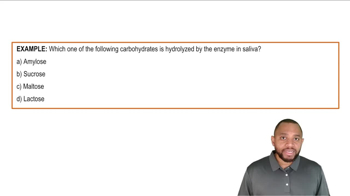Identify a disaccharide that fits each of the following descriptions:
(a) ordinary table sugar
 Verified step by step guidance
Verified step by step guidance



Identify a disaccharide that fits each of the following descriptions:
(a) ordinary table sugar
ALLIED Health Based on the sweetness index in Table 6.2, if you tasted a drop of each of the syrups below, which would taste the sweetest?
(a) light corn syrup (100% glucose)
ALLIED Health If one sweetener packet of Splenda, Sweet’N Low, or Equal has the same sweetness as two tablespoons of sugar, according to Table 6.2, which of the packets contains the smallest amount of the sweetener?
Give the name of one or more polysaccharides that matches each of the following descriptions:
(a) not digestible by humans
Give the name of one or more polysaccharides that matches each of the following descriptions:
(d) produces maltose during digestion
ALLIED Health How is the polysaccharide heparin different from the glucose polysaccharides?